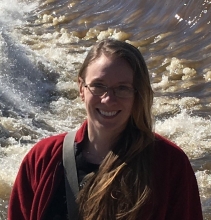
Assistant Professor
Atmospheric and Hydrologic Sciences
St. Cloud State University
Abstract: Excess nitrogen and phosphorus are key players in the degradation of water quality in many U.S. lakes and streams. Non-point nutrient sources, such as agricultural runoff, are major contributors to high nutrient loads that eventually concentrate in coastal areas such as the Great Lakes and the Gulf of Mexico. These loads contribute to harmful algal blooms and hypoxia, and result in both economic and environmental impacts. Studies have shown that a few large runoff events per year contribute to a majority of the annual load, and application of nutrients as fertilizers generally occur during the riskiest times of year for runoff in the region (fall through spring). In response to the need for real-time nutrient application guidance and a request from states in the Great Lakes region, the North Central River Forecast Center has helped develop Runoff Risk tools. Runoff Risk refers to decision support tools that provide farmers and producers actionable guidance for short-term field management decisions such as the timing of nutrient applications. This is done by utilizing real-time information from existing National Weather Service (NWS) weather and hydrologic models. Temperature and precipitation observations and forecasts drive hydrologic models that simulate continuous soil moisture and runoff behavior. Runoff Risk tools are very collaborative partnerships, involving federal and state agencies, universities and private industry representatives. An overview of the past, current and prospective future versions of Runoff Risk as implemented in several Great Lakes states will be presented.
Bio: Andrea Thorstensen is a 2016 graduate of UC Irvine’s civil and environmental engineering doctoral program in hydrology. She studied within the Center for Hydrometeorology and Remote Sensing, focusing on the role of in-situ and remotely sensed soil moisture data in improving distributed hydrologic model simulations. Following her studies at UCI, she joined the hydrometeorology modeling and applications group at the Earth System Research Laboratory in Boulder, CO, via the National Research Council Postdoctoral Fellowship Program. Thorstensen became an operational hydrologist for the North Central River Forecast Center within the National Oceanic and Atmospheric Administration’s National Weather Service in Chanhassen, MN, in 2017. After three years of forecasting for rivers in the Hudson Bay, Upper Mississippi and Western Great Lakes Basins, she joined the Department of Atmospheric and Hydrologic Sciences at St. Cloud State University in St. Cloud, MN, as an assistant professor of hydrology and environmental engineering.
Share
Upcoming Events
-
MSE 298 Seminar: Mechano-Electrochemical Phenomena at Ceramic Electrolyte Interfaces
-
MAE 298 SEMINAR: Rapid Manufacturing and Assembly of High-Performance Thermoplastic Composites
-
CBE 298 Seminar: Beyond the Tailpipe - From the Science of Soot Formation to the Engineering of Carbon Nanomaterials
-
CEE Seminar: Pricing and Control in Emerging Mobility Systems
-
MSE 298 Seminar: Innovation In Materials Science - An Industrial R&D Perspective
